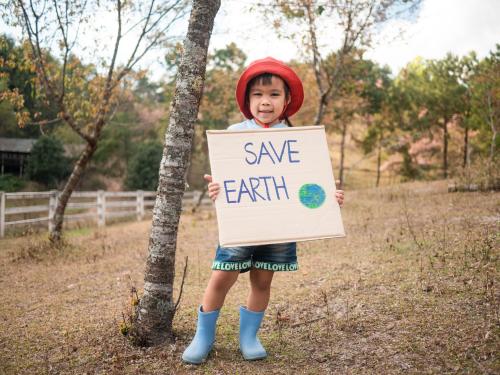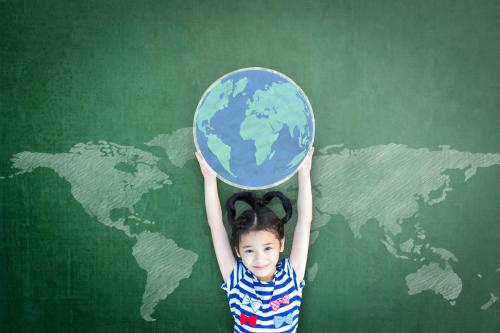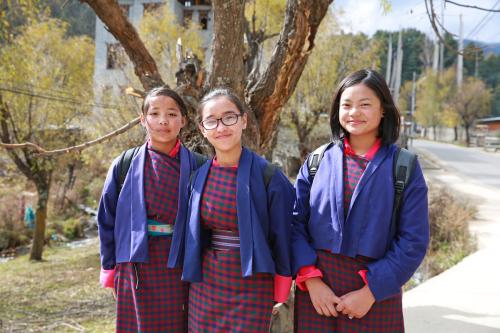What if, with a little leadership from global heads of state, including U.S. President Biden and U.K. Prime Minister Johnson, there was an opportunity to catalyze a movement at home and abroad that combats climate change, strengthens the civic health of communities, closes the learning gap in 21st century workplace skills between low and high-income girls and boys, and strengthens teacher capacity? It might sound too good to be true, but there is an opportunity for political leadership to spearhead what we are calling a new green learning agenda—a new way of educating and engaging children, youth, and adults in climate solutions—by unleashing the creativity of teachers and students to develop and implement climate action projects in their homes, schools, and communities. This approach to teaching and learning is grounded in decades of research on how children learn and helps build mastery of core academic content while also catalyzing climate action.
A powerful connection: Education and climate change
Recent research shows that if only 16 percent of high school students in high- and middle-income countries were to receive climate change education, we could see a nearly 19 gigaton reduction of carbon dioxide by 2050. When education helps students develop a strong personal connection to climate solutions, as well as a sense of personal agency and empowerment, it can have consequential impact on students’ daily behaviors and decisionmaking that reduces their overall lifetime carbon footprint. Imagine if 100 percent of students in the world received such an education. New evidence also shows that the combination of women’s empowerment and education that includes everyone—especially the 132 million out-of-school girls across the developing world—could result in an 85 gigaton reduction of carbon dioxide by 2050. By these estimates, leveraging the power of education is potentially more powerful than solely increasing investments in onshore wind turbines (47 gigaton reduction) or concentrated solar power (19 gigaton reduction) alone. When we say that all climate solutions are needed to draw down greenhouse gases, we must also mean education solutions, too.
When we say that all climate solutions are needed to draw down greenhouse gases, we must also mean education solutions, too.
But beyond education’s potential impact on reducing carbon emissions, education—especially for girls—can save lives in the context of natural disasters exacerbated by climate change by reducing climate risk vulnerability. In a study of 125 countries, researchers found that the death toll caused by floods, droughts, wildfires, extreme temperature events, and extreme weather events could be 60 percent lower by 2050 if 70 percent of women were able to achieve a lower-secondary-school education. Imagine if 100 percent of women were to achieve a full 12 years of education.
An equally important outcome of education is its potential to increase young people’s capacity to adapt to the harsh impacts of climate change by building important knowledge and a breadth of “green skills.” For example, young people need both a strong knowledge base around the causes of a warming climate but also a strong set of skills that will allow them to apply their knowledge in the real world, including problem-solving, critical thinking, teamwork, coping with uncertainty, empathy, and negotiation. Indeed these very “transferable skills” are needed equally to thrive in the world of work and to be constructive citizens.
Today it is those communities that have historically contributed the least to present-day carbon emissions—such as minority and indigenous communities in the U.S. and many low- and middle-income countries and small island developing states—that are often the most vulnerable to its risks and impacts. In the U.S. for example, 6,000 schools are located in flood zones and 1 million children had their learning disrupted during California’s 2018-2019 wildfire season, hitting students in low-income communities the hardest. Across the globe, schools and entire communities in the poorest countries in the world are regularly upended due to severe floods and hurricanes, all expected to worsen in intensity and frequency due to climate change. For example, in 2013 Super Typhoon Haiyan killed more than 6,000 people in the Philippines, damaged or destroyed more than 3,200 schools and day care centers, disrupted the education of more than a million children, and placed 49,000 young girls and women at risk of sex trafficking due to their displacement in crowded and unsafe shelters. For these communities, climate change is an unchecked threat multiplier. Combating climate change is a move toward climate justice and gender justice. And education has a role to play. High quality climate-change education can also help empower girls and youth to become powerful change agents for sustainability in their communities, charting new paths forward for what life can and should be like.
Strong public support: Parents, teachers, and students want education to address climate change
There is growing momentum around the world to harness the power of education to combat and adapt to climate change and ensure young people—especially those girls and boys from the most marginalized communities—have the critical thinking, problem-solving, and collaboration skills needed to take action. In the U.S., 80 percent of parents (2 out of 3 Republicans and 9 out of 10 Democrats) and in the U.K. 77 percent of adults support teaching climate change in school. Teachers and school administrators are eager to take up the challenge but feel they need more training and relevant learning materials to do so. In the U.S., 86 percent of teachers believe climate change should be taught in school, but nearly 60 percent of teachers report they do not teach climate change because they believe it is outside of their subject area. These statistics are similar in other countries with data: In the U.K., 69 percent of teachers agree that there should be more teaching on climate change, yet nearly 75 percent feel that doing so would push them beyond their knowledge and training. In Europe, 71 percent of teachers believe that in two years’ time the public will view climate change as a serious issue to discuss and learn about in school, but again the majority of teachers feel they needed more training and materials to do so.
In recent years, media attention has focused on the increasingly vocal demand from the world’s youth who are demanding leaders take just and equitable climate action, and also ensure present and future generations develop the knowledge, skills, and attitudes to address climate change through education. Nowhere is this more evident than in the millions of students behind the Fridays for Future movement and the hundreds of youth who stepped up to organize a Mock COP26 in place of the postponed 2021 United Nations Climate Change Conference (COP26). Additionally, many of these civicly active students will soon be eligible to vote, which should further drive political support for action. But most students feel schools are not doing enough. A survey in Europe found that just 4 percent of students feel they know a lot about climate change; 42 percent feel they have learned a little, hardly anything, or nothing about it at school; and 57 percent of students want to learn more.
An audacious yet achievable goal: Climate action projects in every school by 2025
Imagine a world where every school community from Afghanistan to Zimbabwe, from China to the U.S. had students actively designing and leading projects aimed at curbing and/or adapting to climate change. In high-emitting countries, these projects might address the most pernicious underlying drivers of climate change and its disproportionate impact on vulnerable groups. For example, in the U.S., students can map and monitor local environmental challenges, analyze local practices, policies, and laws that perpetuate or enable these challenges, and design and implement or advocate for a sustainability plan that addresses the root cause(s). One specific way U.S. students of every age could bring their classroom learning to life is by finding ways to make the the 7 billion school meals served each year more just and sustainable—from sourcing food through school gardens to disposing of it through school composting.
In low-emitting country projects, students could help address the impacts of climate change. For example, young people living in communities near marine-protected areas in Mozambique could test out the real-world application of their biology and social studies lessons by working together to identify and promote the behaviors that help their community become long-lasting stewards of the oceans. And students in Bangladesh’s solar-powered “floating schools,” created in response to frequent school disruptions caused by monsoons and flooding, could connect their science and math lessons to support the hydroponics practice of floating farms; this would strengthen their communities’ livelihoods and climate resilience to help curb the underlying drivers of “famine marriages” experienced by an alarming proportion of young girls.
Integrating this collaborative and experiential learning approach to students’ school experience does far more than harness their energies for the implementation of a global catalog of climate projects. It is one way to begin implementing a new green learning agenda focused on developing deeper understanding of the numerous ways human action can help sustain a planet in balance and build the civic action skills needed to solve collective problems—from climate change to gender inequality to poverty. It will also help build support for a growing call for action from leading advocacy organizations (e.g., EarthDay and The World’s Largest Lesson) on integrating climate change across the curriculum with a focus on civic action. In other words, this learning approach will help build the mindsets and know-how of the world’s young people to be the drivers now and in the future of climate-smart nations.
Achieving this vision over the next five years—when countries will next be taking stock of their commitments to the Paris Agreement—is undoubtedly ambitious. But with the window of time to achieve the 1.5 degrees Celsius target closing by the minute, moonshots are what is needed. Luckily there are four conditions that increase this moonshot’s probability of success and make it not only an audacious but also an achievable goal.
1. Successful models of climate-focused project-based learning exist around the world
In Runesu Primary School in rural Zimbabwe, frequent drought and increasing school dropout led the community—together with CARE Zimbabwe—to install a solar-powered water system on school grounds to feed a school vegetable garden and aquaponics facility.1 Using these projects to inspire hands-on lessons in engineering, aquaponics, agriculture, accounting, project planning, and project management (alongside science and mathematics) has led to a number of positive outcomes, including increased girls’ school attendance, leadership, and empowerment; increased overall student performance by nearly 40 percentage points; and increased community resilience to drought. And across other parts of sub-Saharan Africa, young women are honing their leadership skills through climate activism. For example, young women from CAMFED are engaging in nonformal peer-to-peer project-based learning in climate-smart agriculture to combat climate change, poverty, and gender inequality. Through their community workshops, mentoring, and demonstration farms, these young women have reached over 8,000 people and strengthened the adaptive capacity of even more. Vanessa Nakate, a climate activist from Uganda and recently U.N. Secretary General Youth Envoy, has founded the Rise up Climate Movement, which includes a focus on installing solar cookstoves in school.
In the U.K., Kingsmead Secondary School, a partner of the Green Schools Project, gave students a platform to engage with and respond to environmental issues through student-led projects, including a recycling competition, an energy campaign, vegetable garden, and a walk-to-school campaign. Not only did teachers report that such efforts helped to improve their students’ understanding of climate change, but they also helped to empower students to become agents of change for climate action in their school community and beyond. After one year, the school was able to reduce the amount of recycling going to landfills by 45 percent and after three years saved the school over $50,000 in energy costs. In the U.S., Washington State’s ClimeTime initiative is an example of a successful state-legislated investment in teacher professional development and teacher capacity building to help empower teachers with the confidence and competence to teach climate change. The teacher professional learning communities enable small groups of teacher-to-teacher learning, sharing, and brainstorming on strategies and tools to try out in the classroom and the outdoors (like argument-driven inquiry instruction models or using locally relevant phenomena to drive climate instruction), to reflect on their successes and failures, and to continue to refine their pedagogy in a safe and professional space.
All of these initiatives reflect the good practice principles from the decades of evidence on how children learn best. In “Learning to leapfrog: Innovative pedagogies to transform education,” experiential learning is defined as the range of teaching strategies—such as the project-based learning approaches in the above examples—that puts the learners directly in contact with what is being studied. There is strong evidence to show that this approach helps children learn better. The approach usually includes giving students concrete experiences in their schools or communities, facilitating students’ reflection on these experiences, connecting them to the theoretical concepts being studied, and allowing students to iteratively and actively experiment with how to solve a real-world problem. In one study with primary school students in Nigeria, experiential learning approaches were used to help students understand and address local environmental problems—from deforestation to desertification. Students in the program performed significantly better than those in the control group on measures as diverse as environmental knowledge to skills needed to solve immediate and future environmental problems. Indeed, “A new green learning agenda: Approaches to quality education for climate action” reviews the range of evidence around effective climate change education strategies, which center on experiential approaches broadly and help students develop a sense of personal responsibility and political agency to take action. These types of innovative pedagogical approaches combined with direct instruction in the classroom are essential for developing the types of skills young people need to need to shape behaviors and society, such as creative and collaborative problem-solving, evidence-based decisionmaking, reasoning, empathy, and the ability to communicate a position.
2. There is a diverse coalition of actors ready to scale successful models
Teachers from around the world are joining forces with EARTHDAY.org to advocate for support and attention to climate change from global leaders—including from the heads of state President Biden is convening in April 2021— demonstrating the strong and growing commitment of civil society actors to address climate change. Education International and other teacher organizations and unions around the world have signed onto calls for more support to teach science, truth, and climate change. Environmental groups such as Earth Day Network and sustainable development groups such as Project Everyone have launched campaigns to improve climate change education globally. In countries around the world, local campaign organizations and youth-led climate activist organizations are demanding greater climate action, climate change education, and climate justice. For example, community-based youth movements that link with after school clubs and activities are helping scale climate action through grassroots mobilization, including through Paryavaran Mitra—a large-scale, project-based sustainability learning initiative across India.
Last year in the U.S., 150 individuals from 120 different organizations and networks came together to cohere a collective vision for climate empowerment for the country and developed a national strategic planning framework to put climate change education at the forefront of U.S. climate action. Such a milestone speaks not only to the volume of civil society actors standing at the ready to scale climate change education across the country (and beyond), but also to the level of expertise, experience, and energy that the Biden administration can lean on in this historic moment for climate action. Tapping into this force—and coordinating it through federal leadership—would put the U.S. at the forefront of civil society engagement on climate change education.
3. School systems are the perfect size for scaling climate action
Emerging research suggests the “sweet spot” for climate action is at the scale of 10,000-100,000 people. This is not only because the collective ability to make meaningful action is rooted in local relevance, but also because we reach a certain degree of cost-benefit optimization when it comes to the global impact of our local actions. If we apply this to education systems, this is equivalent to focusing efforts at the school-district level—or the equivalent school administrative cluster, depending on the population size of cities and counties. School districts are the perfect network of institutions that exist in every country in the world that have enough community connection potential to effectively scale green civic learning. Focusing efforts at the local level enables education interventions to be community-driven, which is aligned to what we know about effective climate action and effective climate change education: That is, it needs to be locally-relevant and tied to local environmental justice issues to local community challenges with climate change, and to action and ownership at the community level.
When it comes to concern about climate change, as well as other controversial topics, research shows that children can have a strong influence on their parents’ views.
4. Students can seed public mindset shift on climate change and climate action
Entrenched political ideology among adults is a major barrier to shifting public opinion on climate change and thus widescale behavioral change toward climate action. This could become an insurmountable obstacle to climate action, as we typically think of parents having a strong influence on the beliefs and behaviors of their children, leading us down a vicious cycle of climate inaction. However, when it comes to concern about climate change, as well as other controversial topics, research shows that children can have a strong influence on their parents’ views. Indeed, when given the tools to facilitate conversations with their parents about climate challenges in their community (without explicitly mentioning climate change), children can bypass adults’ highly resistant political ideologies that typically serve as blinders to their ability to recognize risks and take action. The effect of this intergenerational learning is especially seen by girls on their parents, and especially on male parents and conservative parents. And the effect is not limited to just increasing climate concern, but extends to changes in environmental behaviors, like reducing energy consumption and waste production. Such insights not only point to the power of young people, especially girls, but also to the opportunities to catalyze climate action even among those adults for whom the politicization of climate change has cut them off from climate communication.
Three steps to move from ideas to action
Harnessing the creativity of teachers and students to engage in climate action envisions making every educator a climate champion, every school club leader an advocate, and every lesson applicable to solving some dimension of climate change, its underlying drivers, and/or adapting to its impacts. Achieving a new green learning agenda means developing in learners the understanding and skills to address the causes and impacts of climate change at any level of education and across many different subjects. It is not just for secondary school students in science class. Young children learning to read can try their skills on stories about animals and nature, which provide a perfect segue into exploring environmental issues and climate change in the local community and identifying problems to solve. In Spain, kindergarteners in a Design for Change program noticed there was a problem with littering in a local park and decided to install recycling and trash receptacles at child-level height to address it. With the right support—from materials to coaching—teachers and youth club leaders can find many connections to learning about the environment and its connections to climate change in existing curricula, coding clubs, debate competitions, and after school clubs.
This approach of supporting teachers and students to take action today is one that complements and will help build public support for curriculum reform efforts aimed at incorporating climate change education in school policy and achieving the systems transformation needed to realize fully a new green learning agenda. On average, large-scale curriculum reform across education systems takes 10 to 15 years. To date, despite clear global commitments to harness the power of education dating back to the 1992 Earth Summit, only two countries (Italy and New Zealand, and soon to be three with Mexico) have fully integrated climate change into their national curriculum. And only 26 percent of countries’ Nationally Determined Contributions even mention children’s schooling—even less pay attention to education’s important role in achieving gender equality and intergenerational justice. The efforts to include climate change in national curricular requirements, develop more relevant and gender-inclusive technical education for green jobs, and invest in large-scale green public infrastructure that includes schools are all crucial. However, we do not need to wait for these to be accomplished (or even started) to begin implementing a new green learning agenda and harnessing the power of education for climate action. With such high interest from students, teachers, and parents we can begin today with the following three steps.
Step 1: Developing a coalition for action
The first step needed is to develop a diverse coalition of organizations that bring the range of needed expertise to achieve the goal. This will naturally draw on all segments of society from government to civil society to the private sector. There is no shortage of organizations willing and able to participate and it will be essential that the coalition—and the funding mechanisms behind it—is developed in a way that incentivizes the diverse actors to work collaboratively toward achieving the goal. We envision that the coalition would include:
- Content developers. Organizations like the Smithsonian Science Education Center, Green Ninja, Office for Climate Education, or TROP ICSU, with expertise in developing and curating existing teaching and learning materials using experiential learning approaches, focused on learning about the natural environment and climate change, and linking to a range of curricular subjects across grades.
- Teacher networks. Teacher networks, like Education International, Climate Generation’s Teach Climate Network, and National Geographic’s Educator Community, dedicated to peer mentoring, training, and resource sharing with an interest in advancing climate change education.
- Student networks. Student-led extracurricular clubs and youth networks, like the Alliance for Climate Education’s Youth Action Network or the CLEO Institute’s Youth Empowerment Movement, interested in working in their communities to learn about and take action on climate change.
- Media organizations with an interest in sharing the stories of how different school communities around the world are tackling the challenge set before them.
- Technology companies. Technology companies that are willing to give their platforms and tools to help support school communities and the coalition share resources, support implementation, and/or track impact of education interventions on the environment.
- Research organizations. Research organizations with an interest in iteratively capturing and sharing learnings across partners and innovating methods for tracking the impact of educational interventions on both behavioral change and emissions reduction.
- Governments—including the new U.S. administration and the U.K., which will be presiding over the Global Partnership for Education’s Replenishment, G7, and the COP26 presidency this year—interested in furthering teacher and student action through lesson sharing and integration into national digital platforms and/or through increased policy uptake.
- Funders from across the government, multilateral, philanthropic, and corporate sector drawing on those interested in supporting education, as well as those mechanisms funding climate mitigation and adaption activities.
Step 2: Supporting teacher and student creativity
The main lever for reaching the goal we set forth is to unleash teacher and student creativity to identify and address the causes and impacts of climate change in communities—and to do this they need support. Given the wide range of local community-based organizations and international organizations with high interest in this type of work, the rollout strategy should link early adopters and their local ecosystem of community organizations with resources and networks to adapt work to those communities not yet engaged in the topic. Such collaborations should be driven by communities and amplified by organizations such as Education International, National Geographic, the World’s Largest Lesson, and Teach for All, which all have global teacher networks and an interest in experiential learning approaches and social justice topics. The range of activities needed to support teacher and student creativity would include:
The main lever for reaching the goal we set forth is to unleash teacher and student creativity to identify and address the causes and impacts of climate change in communities—and to do this they need support.
- Curating and developing relevant teaching and learning materials. There are many existing teaching and learning materials on climate change but far from all employ experiential and project-based learning strategies and many need to be contextualized to community contents. Therefore, a locally relevant review process is needed to take stock of what exists, particularly with an eye toward materials that meet several key criteria: 1) easy to use, 2) able to be contextualized and made locally relevant, and 3) uses experiential learning approaches. Where there are gaps, new materials will need to be developed. While the approach of empowering teachers and students to bring their learning to life through climate-related projects is a universally applicable principle, the specific strategies of how to do that well must be local. In the U.S., projects may center around schools themselves reducing their carbon footprint, while in Mozambique projects may center around addressing gaps in girls’ education while stewarding wildlife conservation. In urban China, projects may center around responsible consumption and waste management, while in rural China projects may center around environmental stewardship and sustainable use of the country’s major river basins. One approach that should be leveraged to help localize teaching materials and educator resources is to pair teachers and local scientists into “learning pods” where together they develop locally relevant climate-related instructional materials across subject areas.
- Mentoring and coaching teachers and youth leaders. Teachers overwhelmingly trust other teachers the most when it comes to advice and guidance on what and how they should teach. Therefore, peer learning, exchange, and mentoring on how to incorporate climate change projects that use experiential learning approaches into daily activities can be the main lever for supporting teacher practice. Peer learning networks and mentoring are effective but often underutilized approaches to helping teachers build their skills and confidence in tackling new approaches to learning. Good practice exists within a range of organizations that have expertise in peer learning networks for educators, and these can be expanded to include a focus on experiential learning approaches to climate change. Similarly with youth networks, girls’ clubs, and extracurricular activities, building in opportunities for mentoring, leadership development, and enhancing “green life skills” and civic engagement could not only help to combat harmful stereotypes and barriers to opportunities, but also empower girls, marginalized groups, and youth to rewrite their own narratives as agents of change in and for their own communities.
- Sharing good practice. Given the wide range of projects and approaches that will take place in each school community, developing a platform for sharing good practices and lessons learned will be important to deepening and extending the impact of this effort. Sharing stories via a range of platforms that can inspire other organizations, communities, and constituencies by example to tackle climate change will be an important part of helping harness the full power of education to change mindsets.
Step 3: Capturing learnings to advance impact
Achieving an audacious goal requires a crystal clear theory of change, feasible and powerful process monitoring, and a commitment to continuous evaluation and lessons sharing. Tracking impact and collecting the lessons learned for sharing will be an important component of the effort. The insights gathered from doing so will help build momentum in school communities that are not initially engaged in the effort, distill learnings for policymakers from both the climate and education space that are looking for effective strategies to incorporate into teacher development policy or the National Action for Climate Empowerment strategy. The research organizations leading this part of the work would need to:
- Contextualize a theory of change. The primary theory of change behind education for climate action is that quality climate change education leads to pro-environmental social and behavioral change, including growth in environmental literacy, sustainability competencies, and civic dispositions, that are necessary to motivate climate action. To clarify this even further, “A new green learning agenda” suggests that quality climate change education must include five design elements:
- a cognitive point of entry, such as the introduction of a local environmental resource challenge and possible solutions to it;
- an affective dimension that helps cultivate empathy toward the environment;
- an existential component that challenges one’s sense of self and one’s way of living and being;
- an ownership dimension generated by building a sense of responsibility over a local climate solution; and
- opportunities for empowered action through a community action project.
Together with an emphasis on multiple domains of knowledge, including indigenous, place-based, and intergenerational knowledge, climate change education can become an important entry point to developing not only a breadth of “green skills” and pro-environmental behaviors, but also a critical foundation from which to engage in systems transformation. Such a theory of change should be further contextualized and localized by teachers and school leadership for greater relevance to learners.
- Track impact. This is particularly important for overcoming the theory of change “problem” behind education—mainly, that increased levels of education have been associated with increased levels of consumption and thus increased levels of greenhouse gas emissions. Emerging research suggests that it is not any kind of education of which we need more, but rather more quality climate change education that empowers learners with knowledge, strengthens their personal connection to climate solutions, and builds their sense of agency and civic dispositions. Together, these learning gains would create the necessary conditions for the mindset shifts needed to change day-to-day behaviors and decisionmaking with consequential effect in terms of reduced emissions and increased adaptive capacity. To complement our technical solutions to climate change, researchers must be tuned into tracking the impact of different educational solutions at different scales on people and the planet, with an eye toward understanding how context matters.
- Share lessons learned. While currently there are many isolated initiatives to collect and curate climate change education teaching and learning materials and resources, access to these information hubs is merely the first barrier to empowering teachers to teach climate change. A second barrier is teachers’ feelings of confidence and competence in using these resources and applying them to their local contexts and to their subject areas, as indicated by teacher surveys in the U.S., the U.K., and Europe. To address both of these barriers, efforts are needed to catalogue lesson plans or community climate action projects at the school district level (or the equivalent school cluster that covers approximately 10,000-100,000 students) where they will be most relevant for teachers seeking ideas for school projects, youth group leaders to share with their networks, and teachers and student leaders to share lessons learned and ideas to try out in their own classrooms and clubs.
What success looks like
Unleashing the creativity of teachers and students to combat climate change through student-driven and student-led community-based climate action projects would be a quick win for improving the overall quality of education for a 21st century rife with crises. If done at scale across the millions of school districts across the world, we could be well on our way to achieving net-zero emissions by 2050 and to ensuring the quality of life for future generations on this planet.
For starters, such projects could contribute meaningfully to mitigating the causes of climate change (not least by helping to green schools themselves, which often remain public institutions with large carbon footprints) and to adapting to the impacts of climate change (not least by helping build the resilience and adaptive capacity of the most vulnerable—especially girls—to climate impacts, risks, and vulnerabilities). If done with an aim to achieve climate justice, such projects could help seed the social transformations and systems change required to address climate change equitably, including tackling gender inequality, racial discrimination, poverty, and other human rights challenges underlying and exacerbated by climate change. Even our best scientific models suggest that success—that is, achieving the 1.5 degrees Celsius target—is not possible without simultaneously achieving climate justice.
In addition, through participating in the design and implementation of climate action projects, youth will build “green skills,” or their own personal skills and capacities across multiple fronts, including specific capacities like project management skills, cross-cutting 21st century skills like the ability to collaboratively problem-solve, and transformative capacities like collective action and political agency needed for both the world of work and for civic engagement on climate and other social problems. This is especially critical for girls whose leadership and decisionmaking has a demonstrated positive impact on the environment. Teachers would also make large professional gains through stronger peer learning networks that could be used for a range of other topics, adding another way in which countries can build teacher capacity and their professional resilience. Teachers would be more confident and competent not only in teaching climate change across different subjects, but also in experiential, project-based, and inquiry-based learning, which is good teaching practice and can be used for any subject.
The increased relevance of education oriented toward solving local environmental and climate problems is not only a win for society in terms of increasing students’ civic participation and constructive collaboration within their own communities. It also means adding another important player—the education sector—to an important lineup of sectors, like energy, environment, agriculture, transportation, waste management, and infrastructure, working to strengthen the climate-resilience of communities and build a climate-smart nation.
Finally, implementing climate action projects in every school by 2025 will build a groundswell of momentum for climate action and climate justice, especially if community actors are engaged throughout the process. We have seen that the energy of students and their concerns about the environment and interests in climate action can have a ripple effect and help change the mindsets of parents in ways that traditional climate change communication has repeatedly failed. Students—especially girls, empowered by empowered teachers—can help to increase overall public support for climate action, including building demand for the integration of climate change education into curricula and other important dimensions of a new green learning agenda that this “big idea” does not address but for which it can build critical support.
A call to action
When it comes to climate change, humanity sits at an important crossroads with a rapidly closing window of time to take action. We have at our fingertips a big idea—climate action projects in every school by 2025—that through the coordination and activation of a coalition of actors could help set humanity down the path to sustainability. The will is there, as indicated by the millions of youth who have skipped school to demand their governments take greater climate action, as well as the large percentage of teachers who want to teach climate change. It is now time for the U.S. and the U.K., together with global leaders, to seize the moment and step into the leadership role the planet desperately needs.
As the world anticipates global advocacy efforts to shift from explaining why governments need to pay attention to climate change education to how governments can implement climate change education, one way to start—while continuing the long game of curricular integration and reform—is a moonshot idea to unleash the creativity of students and teachers to combat climate change one community at a time.
The year 2021 presents major global opportunities to build this coalition of support further. President Biden’s Earth Day Summit presents an opportunity for the U.S. to announce its plans to prioritize education for climate action, including the resources to back this up—a Brookings Climate Blueprint recommends $2 billion. Countries around the world and multilateral agencies from the United Nations to the development banks have the opportunity to put their money where their mouth is and participate in the replenishment of the Global Partnership for Education to ensure funds and resources will be directed domestically, bilaterally, and multilaterally to education for climate action. Such support and investment are a critical dimension to the success of the Paris Agreement, as education that leads to climate empowerment is the linchpin to our ability to unbridle all other climate solutions and to achieve the 1.5 degrees Celsius target. And the U.K. Presidency of the G-7 and of the much-anticipated COP26 must also mark policy wins for climate change education, not to mention the renewal of a more robust and ambitious plan for education for climate action and the convergence of agendas around girls’ education and climate change.
As the world anticipates global advocacy efforts to shift from explaining why governments need to pay attention to climate change education to how governments can implement climate change education, one way to start—while continuing the long game of curricular integration and reform—is a moonshot idea to unleash the creativity of students and teachers to combat climate change one community at a time.
-
Footnotes
- Matyanga, M. (2019). Building climate resilient schools in Zimbabwe. Unpublished final report. CARE Zimbabwe.








